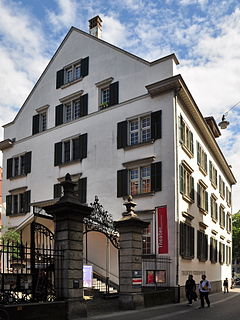Related Research Articles
The foreign relations of Switzerland are the primary responsibility of the Federal Department of Foreign Affairs (FDFA). Some international relations of Switzerland are handled by other departments of the federal administration of Switzerland.
The Swiss Trade Union Federation is the largest national trade union center in Switzerland.
Trade unions in Switzerland have their origins in the 19th Century when the country began to industrialise. Workers' associations first formed in the 1860s which assumed union functions, mutual insurance activities, sponsored candidates for election and campaigned in referendums. In 1873 a number of the associations in the German-speaking areas formed the Workers' Federation, which represented around 5,000 by the late 1870s and campaigned for legislative reform. In 1880, the Workers' Federation dissolved itself into two separate wings; the Swiss Trade Union Federation (SGB/USS) and the Social Democratic Party.

Anne Cuneo was a Swiss journalist, novelist, theatre and film director and screenwriter.

Switzerland–Uruguay relations are foreign relations between Uruguay and Switzerland. Both countries share a long history of mutual economic relations, and they established diplomatic relations in 1828. Uruguay became a popular destination for Swiss migrants starting in the 1860s. In the 20th century, Uruguay has looked to Switzerland as a model for government, historical and cultural ties go back to at least the 19th century. There were 956 people with Swiss passports residing in Uruguay in 2008. Uruguay was described as the "Switzerland of the Americas" in a 1951 New York Times article for its popularity as a haven for capital fleeing Europe at the time and its adoption of Swiss-inspired banking laws. Thomas J. Knight also wrote that "Uruguay has for most of its history been the 'Switzerland' of South America."
Chocolats+Croisier (1815-1950) was a Swiss manufacturer of luxury chocolates. At one time, it was the oldest manufacturer of these products in Switzerland.

The Swiss Social Archives in Zurich is a historical archive, an academic library, a collection of documentation and a research facility specialising in social issues and social movements. The Swiss Confederation recognizes the archives as the country's leading research facility for social issues and social movements. The Social Archives run their own research endowment fund, the Ellen Rifkin Hill Foundation. The SSA play an important role in communicating scholarship to the broader community. They have convened several exhibitions, published essay collections on Swiss social history and conduct lecture series, presentations and information sessions. The archives work with Swiss secondary and tertiary educational institutions, archives and libraries and with similar institutions abroad. The SSA are a founding member of the International Association of Labour History Institutions (IALHI).

The International Graphical Federation (IGF) was a global union federation bringing together unions of printing workers around the world.
The International Federation of Lithographers, Lithographic Printers and Kindred Trades (IFL) was a global union federation bringing together unions representing print workers.
The Danish Lithographers' Union was a trade union representing printers in Denmark.
The French Federation of Book Workers was a trade union representing printing workers in France.

The Union of German Book Printers was a trade union representing printers in Germany.
The Union of Lithographers, Lithographic Printers and Kindred Trades was a trade union representing printers in Germany. It was sometimes referred to as the Senefelder Union, after Alois Senefelder, the inventor of lithography.
The Danish Bookbinders' and Stationers' Union was a trade union representing bookbinders and workers involved in making stationery in Denmark.
The Swiss Typographers' Union was a trade union representing printers, based in Switzerland.
The Union of Printing and Paper was a trade union representing most printing industry workers in Switzerland.
The Swiss Bookbinders' and Carton' Makers' Union was a trade union representing bookbinders, stationers and box makers in Switzerland.
Friedrich Segessenmann was a Swiss trade union leader and politician.
Comedia was a trade union representing print and media workers in Switzerland.
The Swiss Clothing, Leather and Equipment Workers' Union was a trade union representing workers in the clothing and leather industries.
References
- 1 2 "Schweizerischer Lithographenbund (SLB) / Union Suisse des Lithographes / Unione Svizzera dei Litografi". Schweizerisches Sozialarchiv. Retrieved 4 December 2020.
- ↑ Mitchell, James P. (1955). Directory of Labor Organizations: Europe. Washington DC: United States Department of Labor. pp. 28.16–28.24.
- ↑ "Friedrich Segessenmann". Historisches Lexikon der Schweiz. Retrieved 4 December 2020.
- ↑ Coldrick, Percy; Jones, Philip (1979). The International Directory of the Trade Union Movement. New York: Facts on File. pp. 66–70. ISBN 0871963744.
- ↑ "Gewerkschaft Druck und Papier (GDP) / Syndicat du livre et du papier / Sindacato del libro e della carta". Schweizerisches Sozialarchiv. Retrieved 4 December 2020.